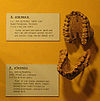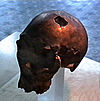인류 진화 화석 목록
List of human evolution fossils| 시리즈의 일부 |
| 고생물학 |
|---|
 |
| 고생물학 포털 카테고리 |
다음 표는 약 700만 년에서 800만 년 전 마이오세 말기에 호미니 부족(인간과 침팬지 혈통의 차이)의 형성을 시작으로 인류의 진화와 관련된 호미닌 화석과 유적의 개요를 보여준다.
대부분 단편적인 수천 개의 화석이 있고, 종종 완전한 두개골과 골격을 가진 하나의 뼈 또는 분리된 이빨로 구성되어 있기 때문에, 이 개요는 완전하지 않지만, 가장 중요한 발견의 일부를 보여준다.화석은 방사성 연대측정 및/또는 증분 연대측정법에 의해 결정되는 대략적인 연령별로 배열되며 종명은 현재 합의를 나타낸다. 명확한 과학적 합의가 없는 경우 다른 가능한 분류가 표시된다.
표시된 초기 화석은 호모 사피엔스의 조상으로 여겨지지 않지만 조상과 밀접한 관련이 있어 혈통 연구에 중요하다.150만 년 전(파란트로푸스의 멸종) 이후, 보여지는 모든 화석은 인간이다.11,500년 전 (11.5 ka, 홀로세 시작) 이후, 보여지는 모든 화석은 호모 사피엔스(해부학적으로 현생 인류)로, 현생 인류의 하위 개체군 형성에 있어 최근 차이를 보여준다.
마이오세 말기(720만~550만년)
침팬지와 인간의 차이는 약 1천만년에서 7백만년 [1]전에 일어났을 것이다.화석 목록은 인간과 침팬지 혈통의 조상일 수도 있고 아닐 수도 있는 약 720만년 전의 그라코피테쿠스로부터 시작된다.인류 계통의 초기 역사에 대해서는 인류 진화 연대표를 참조해 주세요.호민과, 호민과#계통학.
| 이미지 | 이름. | 연령(Ma) | 종. | 연도 발견된 | 나라 | 검출자 | 현재 위치: |
|---|---|---|---|---|---|---|---|
 | 엘 그라에코 | 7.20 | 그라코피테쿠스 | 1944, 2017 | 그리스, 불가리아 사이트: 피르고스 바실리시스, 아즈마카 | 뵈메(튀빙겐), 스파소프(BAS) | 메트(아테네), 튀빙겐(독일) |
 | TM 266 (도마이) | 7.00~6.00[2] | 사헤란트로푸스차덴시스 | 2001 | 차드 사이트: Djurab 사막 | 미셸 브루네, 알랭 보빌랭, 파논 공디브, 마하맛 아둠, 아한타 짐두말바예 | 은자메나(채드), BEAC |
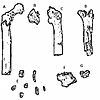 | 바 1000'00 | 6.1~5[3].7 | 오로린투게넨시스 | 2000 | 케냐 사이트: Lukeino | 마틴 픽포드, 킵탈람 체보이, 도미니크 고메리, 피에르 마인, 브리짓 세누트, | |
| 트라킬로스의 발자국 | 5.7 | 호미닌 또는 호미닌 유사 영장류에 의해 만들어진다. | 2002 | 그리스 | 제라드 D.기린스키 | ||
 | ALA-VP 1/20[4] | 5.65±0.150 | 아르디피테쿠스 카다바 | 1997 | 에티오피아 설치장소: 미드 아와시 | 요하네스 하일레 셀라시에 |
플리오센(530~258만년)
갱신세
후기 구석기 시대 : 258만 년 ~ 130만 년
| 이름. | 연령(Ma) | 종. | 날짜. 발견된 | 나라 | 검출자 | 현재 위치: | |
|---|---|---|---|---|---|---|---|
 | KNM-WT 17000 (검은 해골) | 2.50 | 아에티오픽스 | 1985 | 케냐 | 앨런 워커 | |
 | BOU-VP-12/130[21] | 2.50 | 오스트랄로피테쿠스 가르히 | 1997 | 에티오피아 | 요하네스 하일레 셀라시에 | |
 | STS 71[22] | 2.61 -2.07 | 오스트랄로피테쿠스 아프리카누스 | 1947 | 남아프리카공화국, 스테르크폰테인 | 로버트 브룸과 존 T. 로빈슨 | 국립 디송 자연사 박물관 |
 | STS 52 | 2.61 - 2.07 | 오스트랄로피테쿠스 아프리카누스 | 1947 | 남아프리카공화국, 스테르크폰테인 | 로버트 브룸 | 국립 디송 자연사 박물관 |
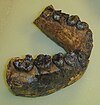 | UR 501(우라하 죠본) | 2.40±0.10 | 호모루돌펜시스[23] | 1991 | 말라위 | 타이슨 미시스카, 티모시 브로마주, 프리데만 슈렌크 | |
 | STS 5 (플레스 부인) (STS 14)[24] | 2.07[25] | 오스트랄로피테쿠스 아프리카누스 | 1947 | 남아프리카공화국, 스테르크폰테인 | 로버트 브룸 | 국립 디송 자연사 박물관 |
| DNH 134(Simon)[26] | 2.04[26] | 호모 에렉투스 | 2015 | 드리몰렌, 드리몰렌 메인 채석장, 남아프리카공화국 | Andy Herries 팀 (Richard Curtis, Andy Herries, Angeline Leece, Jesse Martin에 의해 재구성됨) | 비트바테르스란트 대학교 | |
| DNH 155[27] | 2.04-1.95 | 로부스투스 | 2018 | 드리몰렌 메인 채석장, 남아프리카공화국 | Andy Herries와 Stephanie Bakers 팀(처음 Samantha Good에 의해 발견되고 Samantha Good, Angeline Leece, Stephanie Baker 및 Andy Herries에 의해 발굴됨, Jesse Martin에 의해 재구성됨) | 비트바테르스란트 대학교 | |
| DNH 152 (케티) | 2.04-1.95[26] | 로부스투스 | 2018 | 드리몰렌 메인 채석장, 남아프리카공화국 | Andy Herries와 Stephanie Baker의 팀(첫 번째 부분은 Kethi Nkosi가 발견).나중에 앰버 재거, 유니스 라루니오, Jesse Martin & Angeline Leece에 의해 재구성됨) | 비트바테르스란트 대학교 | |
 | DNH 7 (에우리디스)[28] | 2.04~1.95[26] | 로부스투스 | 1994 | 드리몰렌, 드리몰렌 메인 채석장, 남아프리카공화국 | R. Smith and André Keyser | 비트바테르스란트 대학교 |
 | TM 1517[29] | 2.0 | 로부스투스 | 1938 | 남아프리카 공화국 | 게르트 테르블랑슈 | 국립 디송 자연사 박물관 |
 | MH1(Karabo)[30][31] | 1.98[32] | 오스트랄로피테쿠스 세디바 | 2008 | 말라파, 남아프리카공화국 | 리 R. 버거 | 비트바테르스란트 대학교 |
 | KNM-ER 1813 | 1.90 | 호모 하빌리스 | 1973 | 케냐 | 카모야 기메우 | |
 | KNM-ER 1470 | 1.90 | 호모루돌펜시스 | 1972 | 케냐 | 베르나르 응게노[33] | |
 | SK 48 | 2.25 - 1.80 | 로부스투스 | 1948 | 남아프리카공화국 스와트크란스 | 로버트 브룸 | 국립 디송 자연사 박물관 |
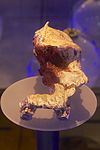 | SK 46[34] | 2.25 - 1.80 | 로부스투스 | 1949 | 남아프리카공화국 스와트크란스 | 로버트 브룸 | 국립 디송 자연사 박물관 |
 | SK 847[35] | 2.25 -1.80 | 호모 하빌리스 | 1949 | 남아프리카공화국 스와트크란스 | 국립 디송 자연사 박물관 | |
 | OH 24 (흔들림)[36] | 1.80 | 호모 하빌리스 | 1968 | 탄자니아 | 피터 은주베 | |
 | OH 8[37] | 1.80 | 호모 하빌리스 | 1960 | 올두바이, 탄자니아 | ||
 | D2700(Dmanisi 스컬 3) | 1.81±0.40[38] | 호모 에렉투스 | 2001 | 그루지야 주 | 데이비드 로드키파니제와 아베살롬 베쿠아 | |
 | D3444(드마니시 스컬 4) | 1.81±0.40 | 호모 에렉투스 | 2003 | 그루지야 주 | 데이비드 로드키파니제 | |
 | D4500(Dmanisi 스컬 5) | 1.81±0.40 | 호모 에렉투스 | 2005년(2013년 기준) | 그루지야 주 | 데이비드 로드키파니제 | |
| KNM-ER 62000–62003[39] | 1.84±0.60 | 호모루돌펜시스 | 2012 | 케냐 쿠비포라 | 미브 리키 팀 | ||
 | OH 5 (Zinj 또는 호두까기 남자) | 1.75 | 청록조롱이 | 1959 | 탄자니아 | 메리 리키 | |
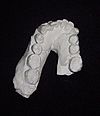 | OH 7 | 1.75 | 호모 하빌리스 | 1960 | 탄자니아 | 조너선 리키 | |
| StW 53 | 1.8~1[25].6 | 여러 가지 아프리카누스, 하빌리스, 가우텐겐시스 | 1976 | 남아프리카공화국, 스테르크폰테인 | A. R. 휴즈 | 비트바테르스란트 대학교 | |
 | KNM-ER 1805 | 1.74 | 호모 하빌리스 | 1973/4 | 케냐 | 폴 아벨 | |
| 위안모우만 | 1.70 또는 0.60~0.50 (표준)[40] | 호모 에렉투스 | 1965 | 중국 | 팡첸 | ||
 | KNM-ER 406 | 1.70 | 청록조롱이 | 1969 | 케냐 | 리처드 리키 | |
 | KNM-ER 732[41] | 1.70 | 청록조롱이 | 1970 | 케냐 | 리처드 리키 | |
 | KNM-ER 23000[42] | 1.70 | 청록조롱이 | 1990 | 케냐 쿠비포라 | 벤슨 경고 | |
 | KNM-WT 17400[43][44] | 1.70 | 청록조롱이 | 알[45] 수 | 투르카나 호(서투르카나 호)케냐 | 미지의[45] | 케냐 국립박물관, 나이로비(케니아) |
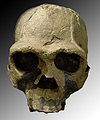 | KNM-ER 3733 | 1.63±0.15[46] | 호모 에르가스터(일명 '호모 에르가스터').아프리카 호모 에렉투스) | 1975 | 케냐 | ||
 | KNM-WT 15000 (투르카나 소년) | 1.60 | 호모 에르가스터(일명 '호모 에르가스터').아프리카 호모 에렉투스) | 1984 | 케냐 투르카나 호(서투르카나 호) | 카모야 키 메우라는 | 케냐 국립 박물관 |
 | Peninj Mandible | 1.50 | 파란 트로푸스 보이 세이 | 1964 | 탄자니아 | 리처드 리키 | |
 | KNM-ER 992년 | 1.50 | 호모 에르가스터(일명 '호모 에르가스터').아프리카 호모 에렉투스) | 1971 | 케냐 | 리처드 리키 | |
 | KNM-ER 3883 | 1.57±0.08 | 호모 에렉투스 | 1976 | 케냐 | 리처드 리키 | |
 | Mojokerto 1 (Mojokerto 아이) | 1.43±0.10 | 호모 에렉투스 | 1936 | 인도네시아 | 안도조, G.H.R. 폰 코닉스왈드 | |
| KGA 10-525[47][48] | 1.40 | 청록조롱이 | 1993 | 에티오피아 콘소가르둘라 | A. 암자이 | ||
 | OH 9 (첼린 맨)[49] | 1.40 | 호모 에렉투스 | 1960 | 올두바이, 탄자니아 | 루이스 리키 | |
 | 아타푸에르카 죠본[50] | 1.20 | Homo sp. | 2008 | 스페인 | 유달드 카르보넬 | 부르고스(스페인) 에볼루시온 후마나 박물관 |
 | 코카바스 | 1.10[51] | 호모 에렉투스 [52] | 2002 | 터키 | M. 시하트 알시체크 | |
 | 다카 | 1.00 | 호모 에렉투스 | 1997 | 에티오피아 | 헨리 길버트 | |
 | 상기란 4 | 1.00 | 호모 에렉투스 | 1939 | 인도네시아 | G.H.R. 폰 쾨니히스왈트 | |
 | 상기란 2 | 1.15±0.45 | 호모 에렉투스 | 1937 | 인도네시아 | G.H.R. 폰 쾨니히스왈트 | |
 | 부야 부인[53] | 1.00 | 호모 에렉투스 | 1997 | 에리트레아 | 에르네스토 아바테 | 에리트레아 국립박물관 |
 | ATD6-15 및 ATD6-69 (니뇨 데 라 그란 돌리나 342) | 0.900[54] | 호모 선행 처리자 또는 호모 에렉투스 | 1994 | 스페인 | 베르무데스와 아르수가 | 부르고스(스페인) 에볼루시온 후마나 박물관 |
| 트리닐 2 피테칸트로푸스-1 또는 자바맨[55] | 0.850±0.150 | 호모 에렉투스 | 1891 | 인도네시아 | 외젠 뒤보아 | 레이든 내추럴리스 생물다양성센터 | |
 | 테르니핀 2-3 현재 티게니프[56] | 0.70 | 호모 에렉투스 | 1954 | 알제리 | C. Arambourg & B.호프테터 | |
 | 상기란[57] 17 | 0.70 | 호모 에렉투스 | 1969 | 인도네시아 | 사르토노 | |
 | 북경인 | 0.73±0.50[58] | 호모 에렉투스 | 1921 | 중국 | 데이비드슨 블랙 | 분실/도난 |
 | 보도[59] | 0.600 | 호모하이델베르겐시스 또는 호모 에렉투스 | 1976 | 에티오피아 | A. 아스파우 | |
 | 마우어 1 (하이델베르크 사나이) | 0.50 | 호모하이델베르겐시스 | 1907 | 독일. | 다니엘 하르트만 | 하이델베르크 대학교 |
 | 살단하인[60] | 0.50 | 호모로디지엔시스 | 1953 | 남아프리카 공화국 | ||
| 박스그로브맨 | 0.50[61] | 호모하이델베르겐시스 | 1994 | 영국 | 자연사박물관 | ||
 | 아라고21 (자전거맨) | 0.45 | 호모 에렉투스 | 1971 | 프랑스. | 헨리 드 럼리 | |
| 아르길 세프라노 맨[62][63] | 0.450±0.050 | 호모 세프라넨시스 /호모하이델베르겐시스 | 1994 | 이탈리아 세프라노 | 이탈로 비디투 | 이탈리아, 레기오네 라치오 주, 소프린텐덴차 아이베니 컬처리의 세르비치오 디 항로폴로지아 | |
 | 가위스두개 | 0.350±0.015 | 호모 에렉투스/호모 사피엔스 | 2006 | 에티오피아 | 아사메드 후멧 | |
 | 스컬 5(미구엘론) | 0.400 | 호모하이델베르겐시스 | 1992 | 스페인 | 베르무데스, 아르수가 & 카르보넬 | 부르고스(스페인) 에볼루시온 후마나 박물관 |
 | 아로에라 3 | 0.40 | 호모하이델베르겐시스 | 2014 | 포르투갈 | [주앙 질항 [de] 주앙 질항] | 리스본 국립미술관 |
 | 살레[64][65][66] | 0.40 | 호모로디지엔시스 | 1971 | 모로코 | 채석장 노동자 | |
 | 스완스콤맨[67] | 0.40 | 호모 네안데르탈렌시스 | 1935, 1936, 1955 | 영국 | 앨번 T 마스턴, 존 J 와이머, 에이드리언 깁슨 | 자연사박물관 |
 | 은두투[68] | 0.40 | 호모 로데지엔시스,[69][70] 후기 호모 에렉투스 [71]또는 초기 호모 사피엔스[72] | 1973 | 탄자니아 | A.A. 무투리 | |
| [73] | 헥시안 두개골 볼트(PA 830)[74][75] | 0.412±0.025 | 호모 에렉투스 | 1980 | 헥셴(중국) | ||
 | 스타인하임 스컬 | 0.35 | 호모하이델베르겐시스 | 1933 | 독일. | ||
 | 디날레디 챔버 호미닌 | 0.140±0.090[76] | 호모 나레디 | 2013 | 남아프리카 공화국 | 릭 헌터와 스티븐 터커 | 비트바테르스란트 대학교 (남아공) |
| BH-1 | 0.4[77] | 호모하이델베르겐시스 | 세르비아 |
중기 구석기 시대: 300,000~50,000년 전
| 이름. | 나이(ka) | 종. | 연도 발견된 | 나라 | 검출자 | 현재 위치: | |
|---|---|---|---|---|---|---|---|
| 드래곤 맨 | 309–138 | 호모롱기 | 1933 | 중국 | 허베이 지오 대학 | ||
 | 부서진 언덕 1 (카웨 1, 로지시안 맨) | 299±25[78] | 호모 로데지엔시스(호모 하이델베르겐시스) | 1921 | 잠비아 | 톰 즈비글라르 | |
 | 제벨 이르후드 1-5 | 315±32[79] | 호모 사피엔스 | 2017 | 모로코 | INSAP | |
 | 사무 | 275±25 | 호모하이델베르겐시스 | 1964 | 헝가리 | 라슬로 베르테스 | |
| [80] | 달리맨 | 260±20[81] | 호모 에렉투스 호모 하이델베르겐시스나 초기 호모 사피엔스나 | 1978 | 중국 | 류선창 | |
 | 플로리스배드 스컬 | 259±35 | 초기 호모 사피엔스 또는 호모 하이델베르겐시스 또는 Homo Helmei | 1932 | 남아프리카 공화국 | T. F. 드레이어, G. 벤터 | |
 | 갈릴리 맨 | 250±50 | 호모하이델베르겐시스 | 1925 | 이스라엘 | 프란시스 투르빌-페트르 | |
| 사카포스토어 1 | 250[82] | 호모 네안데르탈렌시스 | 1929 | 그로타 과타리 / 이탈리아 | 마리오 그라니올리 | ||
| [83] | 사카포스토어 2 | 250 | 호모 네안데르탈렌시스 | 1935 | 그로타 과타리 / 이탈리아 | 앙리 브로일과 알베르토 카를로 블랑 | |
| 웨일스 덴비셔의 본트뉴이드 구석기 시대 유적 | 230 | 호모 네안데르탈렌시스 | 1981 | 웨일스, 영국 | |||
| 아피디마 1호 (LAO 1/S1) | 210[84] | 호모 사피엔스 | 1978 | 아피디마 동굴 / 그리스 | 테오도르[85] 피티오스 | ||
 | 페트랄로나 1호 | 200±40[86] | Homo Heidelbergensis (불확실) | 1960 | 그리스 | ||
| 오모가 남다 | 233±22[87] 또는 195±5[88] | 호모 사피엔스 | 1967 | 에티오피아 | 리처드 리키 | ||
| 라테라이트 베이비 | 190(?)[89] | 에렉투스 또는 사피엔스 | 2001 | 타밀나두, 인도 | P 라젠드란 | ||
| 미스리야-1 | 187±13[90] | 호모 사피엔스 | 2002 | 이스라엘 | 이스라엘 헤르쉬코비츠 | ||
| 아피디마 2 (LAO 1/S2) | 170[84] | 호모 네안데르탈렌시스 | 1978 | 아피디마 동굴 / 그리스 | 테오도르[85] 피티오스 | ||
 | 펑후 1호 | 160±30 또는 40±30[91] | 호모차이창엔시스[92][93][94] | c. 2008년 | 대만 | 국립자연과학박물관 | |
 | 헤르토 잔존 [95] | 160 | 1997 | White tim tim tim | |||
 | 160[96] | 1980 | ★★★ | ||||
| 151±21[97] | 1993 | ||||||
 | 네셔 람라 호모 | 140±120 | 네셔 람라 호모 or or or openicle. | 2021 | |||
| 140±120 | 초기 현생인류, ★★★★★★★★★★★★★★★★★」 | 1958 | 중국 사오군 | 고생물 및 | |||
 | 18 좌측 18 | 120±30 | 1976 | 탄자니아 라에톨리의 은갈로바 침대 | [98] | ||
 | c c C1 [99] | 120 | 1967 | ||||
 | 7월 7일 | 112[100] | 1931 | C. Ter Haar와 G. H. R. 폰 쾨니그스왈드 | |||
| 8 | 110[101][102] | 2010 | |||||
 | 나 3 [아쉬움직임] | 113.5±13.5[104] | 1899 | 크람베르거 | |||
 | 6호 [105] | 95±5[104] | 1930 | , M. R., M. Neuville, M. Stekelis R. | |||
 | 100 ~ 90[104] | [아쉬움직임] [아쉬움직임] | 1933 | B. 반데르미어쉬 | |||
| 103±23[104] | 1993 | ||||||
 | 5★★★★5 | 100±20 | 1933 | T과 H. McCown H. | |||
| 9월 9일 | 100±20 | ||||||
| [108] | 강 | 100±25 | 1960 | 공화국 | Inskeep, Singer, Deacon, 로 ray ray ray ray, ray ray ray ray ray, ray ray ray ray ray ray ray ray ray ray 、 ray ray ray 、 ray ray ray ray 、 ray ray ray ray ray ray ray ray ray ray ray ray ray ray ray | ||
 | 117 | 1995 | 공화국 | David Roberts & Lee R. 버거 | |||
 | [아쉬움직임] [110] [아쉬움직임] | 90 | 하이브리드 – (호모 네안데르탈렌시스/호모 사피엔스 데니소바) | 2012 | 데니소바 동굴/시베리아/러시아 | 비비안 슬론 & 스반트 파보 | 막스 플랑크 진화 인류학 연구소(라이프치히, 독일) |
| 1 [112] | 칠십오[104] | 2003 | |||||
 | [아쉬움직임] | 70 | 1938 | A. | |||
 | 1 | 70 | 1909 | 과 DR. Capitan d D. | |||
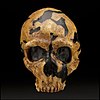 | 1 | 70±10 | 1961 | ||||
 | 1 | 60 | 1908 | A and J. . Bardon | |||
 | 케바라2(모쉐)[114] | 60 | 1983 | ||||
| [115] | 55±5 | ||||||
 | LB 1 ( 빗) ) | 55±5 | 2003 | 인도네시아, 량부아 | 브라운 | ||
| 1 노 1 | 55 | 2008 | [아쉬움직임] | ||||
 | 나 5[필요한 건] | 52.5±7.5[104] | |||||
 | [필요한 건] | 52.5±7.5[104] | |||||
 | [아쉬움직임] | 54.5±8.5[117][118] | 2009 |
후기 구석기 시대: 50,000~11,500년 전
| 름 name 。 | 나이(ka) | 종. | 된 「」 | ★★ | 출출에 의해 되었습니다. | 재재에 있습니다. | |
|---|---|---|---|---|---|---|---|
 | 50±10 | 2007 | ★★★★★★★★★★★★★★★★★」 | 플로렌트 데트로이트 & 아르망 미자레스 | |||
 | 50±10 | 1974 | |||||
 | 산 1 [119] | 50±10 | 1939 | ||||
| SID-00B | 49.2±2.5[120] | 1994 | 시드론 동굴, 스페인 | ||||
| 4 | 543.5±2.5 | 1927 | |||||
 | 1 [아쉬움직임] | 41[122] | 1961 | 스즈키 | |||
 | [123] | 40 | 1856 | 카를 | |||
 | 데니소바 호미닌(X-우먼) | 40 | Homo sp. | 2008 | 요하네스 크라우즈 등 | ||
 | 40 | Homo sp. 알타이(네안데르탈인과 데니소반과의 잡종일 가능성이 있음 | 2010 | ||||
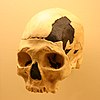 | 1 | 42~37[124] | 호모 사피엔스(EEMH x 네안데르탈인의 잡종) | 2002 | |||
| 나 고라 Kostenki-14 (마키나 고라) | 40~37[125] | 호모 사피엔스(EEMH) | 1954 | ||||
| SID-20[126] | 37.30±0.83[120] | 1994 | 시드론 동굴, 스페인 | ||||
| 고다 만 | 37 | 2012 | |||||
 | 36 | 1952 | 공화국 | ||||
 | 1 1 1 호 1★ [아쉬움직임] | 33±4.5[128] | 호모 사피엔스(프로토오스트레일리아[129]) | 1888 | |||
| 의 | 33 | 1823 | 웨일스, 영국 | ||||
| 32 | 1962 | ||||||
 | 2 | 40±10[104][130] | 1829 | 샤를 | |||
 | 지브롤터 | 40±10[104] | 1848 | 에드먼드 플린트 대위 | |||
 | 40±10 | 1909 | |||||
 | 40±10 | Homo sp. | 2000 | ||||
 | 1 | 30 | 호모 사피엔스(EEMH) | 1868 | |||
| WLH-50 | 29±5 | 1982 | |||||
 | 3 [아쉬움직임] | 26 | 1894 | 야로슬라프 | |||
| 24.5 | or or or openicle. | 1998 | |||||
| 영국 웨일스[132] 칼데이섬 엘포인트산 중상부 구석기 인간 상완골 | 24 | 1997 | 웨일스, 영국 | ||||
| MA-1 ( 타타 ma ma) | 24 | 호모 사피엔스(ANE) | 1920년대 | ||||
 [아쉬움직임] [아쉬움직임] | 1호점 | 17±1 | 1970 | 인류학 | |||
| [134] [135] | 17 | 1967 | |||||
 | [아쉬움직임] [137] | 14.7 | 2010 | ||||
 | 13개[138] | 1965 | |||||
| "코티아스'[139] | 13 | 호모 사피엔스(CHG) | 조지아 주 코티아스 클데 동굴 | ||||
| 맨 | 13개[140] | 1959 | ★★★ | ||||
 | 찾기 | 14.5±2.5[141] | 1888 | ||||
| 나 1 | 14 | 호모 사피엔스(WHG) | 1988 | ★★★★★★★★★★★★★★★★★」 | |||
| 13.7 | 호모 사피엔스(WHG) | 1956 | ★★★★★★★★★★★★★★★★★」 | ||||
| 사슴 | 13±1.5 | 1979 | ★★★ | ★★★★★★★★★★★★★★★★★★? | |||
| PES-1[142] | 31-29 | 불확실, 아마도 호모 사피엔스 | 르르 serbia아 serbia | ||||
| PES-2 | 38.9-92 | 불확실, 아마도 호모 네안데르탈렌시스 | 르르 serbia아 serbia |
홀로세(11,500~5,000년)
| 름 name 。 | 나이(ka) | 화 / / 「」. | ★★★★ 된 「」 | ★★ | |
|---|---|---|---|---|---|
 | 11.5[143] | 인디언 | 1975 | 라질 brazil | |
| [아쉬움직임] | 2 cer cer2 [아쉬움직임] | 11 | 1936 | ★★★ | |
| "사츠르블리아' | 10 | 백인 착생기(CHG)[139] | 주 | ||
 | Swamp 1 1호 | 13-9 | 1968 | ★★★★★ | |
 | 스컬 [아쉬움직임] | 10±1 | 1886 | ★★★★★ | |
 | 브레아 | 10 | 인디언 | 1914 | ★★★ |
 | 9.6 (기원전 [147]7600년) | 시대 | 1909 | ||
| 9500 BP ~7000 BP (주의: 6390[148] BP) | 신석기 | 1927 | mali | ||
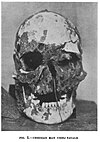 | ) 9(기원전 7000년) | 시대 | 1903 | ||
| 맨 | ) 9(기원전 7000년) | 1996 | ★★★ | ||
 | 8±3 | 인디언 | 1947 | ||
 | [아쉬움직임] | 8 (6000년) | 유럽 중석기(WHG) | 1935 | |
 | 7.9±0.1 | 인디언 | 1931 | 미네소타, 미국 | |
| 로타감 4b(Lo 4b)[150] | 7.5±1.5 [아쉬움직임] | ~ 1965년 ~ 1965년 ~ 1965년 | ★★★ | ||
 | [아쉬움직임] | 7.3-7.2 | 2015 | 술라웨시, 인도네시아 | |
 | ö | ( 5.3 (기원전 3300) | 신석기 | 1991 | 이탈리아 외츠탈 알프스 |
카탈로그
- AL – 에티오피아, Far Locality
- ARA-VP – 아라미스, 아라미스
- BAR – (루케이노, 투겐힐스) 케냐 바링고 구
- – 척추동물OU-VP – " " " " "
- D – 그루지야 주, 드마니시
- ER – 케냐 동부(호수) 루돌프
- – KGA – Konso-Gardula
- – KNM – KNM – KNM - KNM - KNM - KNM - KNM - KNM - KNM - KNM - K
- – – Kanapoi – KenyaKP – Kanapoi – KenyaKP
- LB – Liang Bua (인도네시아)
- LH – Laetoli Hominid 4, 탄자니아
- MH – 말라파 호미닌, 남아프리카공화국
- NG – 인도네시아 Ngodong
- OH – 올두바이 호미니드, 탄자니아
- SK – Swartkrans, 남아프리카공화국
- Stw Strkfontein (남아공)
- TM – 남 tm tm tm tm tm tm tm tm tm tm tm
- – – ,, 、 Toros-Menalla
- WT – 케냐 서부(호수) 투르카나
「」도 .
읽기 ★★★★★★★★★★★★★★」
- 기븐스, 앤최초의 인간: 우리의 가장 오래된 조상을 찾기 위한 경주.앵커북(2007) ISBN
- 를 클릭합니다Hartwig, Walter Carl (2004) [2002]. Hartwig, Walter (ed.). The Primate Fossil Record. Cambridge University Press. Bibcode:2002prfr.book.....H. ISBN 978-0-521-08141-2..
- 요한슨, 도널드 & 웡, 케이트Lucy의 유산: 인류의 기원을 위한 탐험.Three Rivers Press (2009년).ISBN 978-0-307-39640-2
- Jones, Steve; Martin, Robert D.; Pilbeam, David R, eds. (1994). The Cambridge Encyclopedia of Human evolution. Cambridge University Press. ISBN 978-0-521-46786-5. (주: 이 책에는 영장류 전반의 진화, 특히 화석사를 포함한 인류의 진화에 관한 매우 유용한 정보 밀도가 높은 장들이 포함되어 있습니다.)
- 리키, 리처드 & 르윈, 로저원산지 재고: '우리를 인간으로 만드는 것을 찾아서'Little, Brown and Company(1992)ISBN 0-316-90298-5
- 르윈, 로저논쟁의 골자: 인류의 기원 찾기에 대한 논란.펭귄북스(1987년).ISBN 0-14-022638-9
- Morwood, Mike & Van Oosterzee, Penny.새로운 인간: 인도네시아 플로레스의 '호빗족'에 대한 놀라운 발견과 이상한 이야기.Smithsonian Books (2007).ISBN 978-0-06-089908-0
- 오펜하이머, 스티븐아웃 오브 에덴: 세계의 사람들.순경(2003)ISBN 1-84119-697-5
- 로버츠, 앨리스놀라운 휴먼 여정확실한 휴먼 여정: 우리가 어떻게 지구를 식민지화했는지에 대한 이야기.Bloomsbury (2009년).ISBN 978-0-7475-9839-8
- 쉬리브, 제임스네안데르탈인의 수수께끼: 현대 인류 기원의 미스터리를 푸는 것.바이킹(1996년).ISBN 0-670-86638-5
- 스트링거, 크리스우리 종족의 기원.앨런 레인(2011).ISBN 978-1-84614-140-9
- Stringer, Chris & Andrews, Peter.인류 진화의 완전한 세계.Thames & Hudson (2005년).ISBN 0-500-05132-1
- Stringer, Chris & McKie, Robin.아프리카 탈출: 현대 인류의 기원조너선 케이프(1996년).ISBN 0-224-03771-4
- 반 우스터지, 페니북경 남자 이야기Allen & Unwin(1999년).ISBN 1-86508-632-0
- 워커, 앨런, 시프먼, 팻뼈의 지혜: 인간의 기원을 찾아서Weidenfeld & Nicolson (1996).ISBN 0-297-81670-5
- 웨이드, 니콜라스동트기 전: 잃어버린 선조들의 역사를 되찾다.Penguin Press (2006년).ISBN 978-0-7156-3658-9
- Weiss, M.L.; Mann, A.E. (1985). 'Human Biology and Behaviour: An anthropological perspective (4th ed.). Boston: Little Brown. ISBN 978-0-673-39013-4. (주: 이 책에는 인간과 인간이 아닌 영장류, 그들의 진화, 화석 역사에 대한 매우 접근하기 쉬운 설명이 포함되어 있습니다.)
- Wells, Spencer (2004). The Journey of Man : A Genetic Odyssey. New York: Random House Trade Paperbacks. ISBN 978-0-8129-7146-0.
레퍼런스
- ^ "실제로 지금 아무런 선험적인 근거 특히 최근의 것이다 그human-chimpanzee 분할 시간을 가정하는 것, 그리고 화석 증거는 이제 완전히 나이 든chimpanzee–human 발산 날짜와 호환되는은[7살~10 마는]"화이트 TD, Asfaw B, Beyene Y,(알.(2009년 10월)."초기 원인의 아르디 피테 쿠스 ramidus고 순고 생물학".과학.326(5949):75–86.Bibcode:2009Sci...지금 326호...75W.doi:10.1126/science.1175802.PMID 19810190.S2CID 20189444.
- ^ Brunet, Michel; Guy, Franck; Pilbeam, David; Mackaye, Hassane Taisso; Likius, Andossa; Ahounta, Djimdoumalbaye; Beauvilain, Alain; Blondel, Cécile; Bocherens, Hervé (2002). "A new hominid from the Upper Miocene of Chad, Central Africa". Nature. 418 (6894): 145–51. Bibcode:2002Natur.418..145B. doi:10.1038/nature00879. PMID 12110880. S2CID 1316969.
- ^ "Bar 10200'". Smithsonian National Museum of Natural History. 2010-01-23. Retrieved 2012-07-27.
- ^ "Ardipithecus kadabba". efossils. Retrieved 26 March 2015.
- ^ Amos, Jonathan (2009-10-01). "Fossil finds extend human story". BBC News.
- ^ Kissel M, Hawks J (2015). "What are the Lothagam and Tabarin Mandibles?" (PDF). PaleoAnthropology: 37. doi:10.4207/PA.2015.ART94 (inactive 28 February 2022).
{{cite journal}}: CS1 유지 : 2022년 2월 현재 DOI 비활성화 (링크) - ^ McDougall, I.A.N.; Craig, Feibel (1999). "Numerical age control for the Miocene-Pliocene succession at Lothagam, a hominoid-bearing sequence in the northern Kenya Rift". Journal of the Geological Society. 156 (4): 731–45. Bibcode:1999JGSoc.156..731M. doi:10.1144/gsjgs.156.4.0731. S2CID 128952193.
- ^ Bernard Wood, Wiley-Blackwell Encyclopedia of Human Evolution (2011), 887.
- ^ a b c Hill, Andrew; Ward, Steven (1988). "Origin of the Hominidae: the record of African large hominoid evolution between 14 My and 4 My". Yearbook of Physical Anthropology. 31 (59): 49–83. doi:10.1002/ajpa.1330310505.
- ^ Patterson B, Behrensmeyer AK, Sill WD (June 1970). "Geology and fauna of a new Pliocene locality in north-western Kenya". Nature. 226 (5249): 918–21. Bibcode:1970Natur.226..918P. doi:10.1038/226918a0. PMID 16057594. S2CID 4185736.
- ^ Lothagam 하악골 단편 2011-07-16 Wayback Machine에 보관
- ^ Ward, Steven; Hill, Andrew (1987). "Pliocene hominid partial mandible from Tabarin, Baringo, Kenya". American Journal of Physical Anthropology. 72 (1): 21–37. doi:10.1002/ajpa.1330720104. PMID 3103460.
- ^ Heslip, Steven (2001). "Australopithecus anamensis". Archived from the original on June 8, 2011.[자체 인식 소스?]
- ^ "Oldupai". Ntz.info. Retrieved 2012-10-15.
- ^ Anthropology, The University of Texas at Austin, Department of. "Kenyanthropus platyops: KNM WT 40000". www.efossils.org.
- ^ "KNM-WT 40000". 23 January 2010.
- ^ "New human ancestor species from Ethiopia lived alongside Lucy's species". www.sciencedaily.com. 27 May 2015. Retrieved 2015-05-28.
- ^ http://www.modernhumanorigins.net/al444-2.html 2010년 08월 29일 Wayback Machine Image at Modern Human Origines (현대의 인류의 기원)에서 아카이브 완료
- ^ http://www.eurekalert.org/multimedia/pub/87535.php 이미지 at Eurekalert
- ^ Villmoare, 브라이언, Kimbel, 윌리엄 H.,.Seyoum, Chalachew, Campisano, 크리스토퍼 J., 디마 지오, 에린은 N, 로언, 존은 브라운, 데이비드 R., 화살 만드는 사람, J. 라몬, 리드, 케이 E.(2015-03-20)."초기 호모 2.8마 총통에 Ledi-Geraru, 아파르는 에티오피아의".과학.347(6228):1352–55.Bibcode:2015Sci...347.1352V. doi:10.1126/science.aaa1343.ISSN 0036-8075.PMID 25739410.:"Gurumaha 응회암#용결 응회암 방사 측정 2.842±0.007 엄마, Gurumaha 섹션이 가우스 Chron의 정상적인 자기 극성과 일치하고 있는 데이트에는 날짜가 있다.LD 350-1의 상한 연령은 2.665±0.016 Ma Lee Adoyta Tuff를 포함하는 다운폴트 상태의 인접 젊은 블록에 의해 제공됩니다.[...] LD 350-1의 연령은 층서학적 스케일링에 의해 더욱 제한될 수 있습니다.[...] [Ledi-Geraru, 3501에 대한 현재 크로노스트라티그래픽 프레임워크에 근거하고 있습니다.
- ^ 부리척추동물고생물학
- ^ http://humanorigins.si.edu/evidence/human-fossils/fossils/sts-71 Smithsonian 이미지
- ^ 발견 당시 인류의 가장 오래된 화석 증거로 간주된다.라미레즈 로치, 페르난도 V;Bromage, 팀;Schrenk, 프리데만(1997년).말라위에서 "UR501, Plio-Pleistocene 유인원.그 enamel"의 조직학의 분석.Comptes Rendus 드 l'Académie 데 과학, Série IIA.325(3):231–234.Bibcode:1997CRASE.325..231R. doi:10.1016(97)88294-8..이후 LD350-1의 발견(2.8엄마, 오스트랄로 피테쿠스와 호모의 중간)거의 틀림없이 호모의 둘째 화석의 계급으로 강등되다.
- ^ : CS1 maint: 제목 (링크)이미지로서 보관된 카피(모던 휴먼 오리진스"Archived copy". Archived from the original on 2006-01-18. Retrieved 2006-07-11.
{{cite web}})."Australopithecus africanus". Australian Museum. 20 January 2011. - ^ a b Herries, Andy I.R.; Shaw, John (2011). "Palaeomagnetic analysis of the Sterkfontein palaeocave deposits: Implications for the age of the hominin fossils and stone tool industries". Journal of Human Evolution. 60 (5): 523–39. doi:10.1016/j.jhevol.2010.09.001. ISSN 0047-2484. PMID 21392817.
- ^ a b c d e Herries, Andy (2020). "Contemporaneity of Australopithecus, Paranthropus, and early Homo erectus in South Africa". Science. 368 (6486): eaaw7293. doi:10.1126/science.aaw7293. hdl:11568/1040368. PMID 32241925. S2CID 214763272.
- ^ Martin, Jesse M.; Leece, A. B.; Neubauer, Simon; Baker, Stephanie E.; Mongle, Carrie S.; Boschian, Giovanni; Schwartz, Gary T.; Smith, Amanda L.; Ledogar, Justin A.; Strait, David S.; Herries, Andy I. R. (2020-11-09). "Drimolen cranium DNH 155 documents microevolution in an early hominin species". Nature Ecology & Evolution. 5 (1): 38–45. doi:10.1038/s41559-020-01319-6. ISSN 2397-334X. PMID 33168991. S2CID 226296091.
- ^ "Modernhumanorigins.net". www.modernhumanorigins.net. Archived from the original on 2010-06-17. Retrieved 2007-03-18.
- ^ Department of Anthropology: The University of Texas at Austin. "Paranthropus robustus: TM 1517". Retrieved 2014-06-09.
- ^ http://www.scientificamerican.com/article.cfm?id=south-african-hominin-fossil Scientific American의 MH1 이미지
- ^ Juliet King (June 4, 2010). "Australopithecus sediba fossil named by 17-year-old Johannesburg student". Origins Centre. Archived from the original on March 25, 2012. Retrieved 2011-07-09.
- ^ Amos, Jonathan (2011-09-08). "African fossils put new spin on human origins story". BBC News. Retrieved 9 September 2011.
- ^ Mai, L.L., Owl, M.Y, & Kersting, M.P. (2005), 페이지 286
- ^ "SK 46". 24 January 2010.
- ^ "Modernhumanorigins.net". www.modernhumanorigins.net. Archived from the original on 2007-09-27. Retrieved 2007-03-18.
- ^ http://humanorigins.si.edu/evidence/3d-collection/oh-24 Smithsonian 이미지
- ^ http://www.modernhumanorigins.net/oh8.html 2010-12-08년 Wayback Machine에서 아카이브 완료 OH8 모던 휴먼 오리진스 다리 이미지
- ^ Lordkipanidze, D.; de Leon, Ponce; Margvelashvili, A.; Rak, Y.; Rightmire, G. P.; Vekua, A.; Zollikofer, C. P. E. (2013). "A Complete Skull from Dmanisi, Georgia, and the Evolutionary Biology of Early Homo". Science. 342 (6156): 326–31. Bibcode:2013Sci...342..326L. doi:10.1126/science.1238484. PMID 24136960. S2CID 20435482.
- ^ Leakey MG, Spoor F, Dean MC, et al. (August 2012). "New fossils from Koobi Fora in northern Kenya confirm taxonomic diversity in early Homo". Nature. 488 (7410): 201–04. Bibcode:2012Natur.488..201L. doi:10.1038/nature11322. PMID 22874966. S2CID 4431262.에프
- ^ 인버티드 스트라타 2006-10-02 Wayback Machine 아카이브 완료
- ^ Donald C. Johanson; Blake Edgar (1996). From Lucy to Language. New York: Simon & Schuster. p. 158.
- ^ 스미소니언에서의 이미지
- ^ Leakey, R. E. F.; Walker, A. C. (1988). "New Australopithecus boisei specimens from East and West Lake Turkana, Kenya". American Journal of Physical Anthropology. 76 (1): 1–24. doi:10.1002/ajpa.1330760102. ISSN 1096-8644. PMID 3136654.
- ^ Grine, Frederick E. (2007). Grine, Frederick E. (ed.). Evolutionary History of the "Robust" Australopithecines. Transaction Publishers. pp. 99, 185–86, 247. ISBN 978-0202365961. Retrieved 16 February 2015.
- ^ a b Wood, Bernard (2011). Wood, Bernard (ed.). Wiley-Blackwell Encyclopedia of Human Evolution, 2 Volume Set. doi:10.1002/9781444342499. ISBN 978-1444342475. Retrieved 11 May 2014. 이 책의 참고 자료를 열람할 수 있습니다.
- ^ Lepre, C.J., 켄트, D.V(2010년)."올두바이 Subchron은 Koobi Fora 형성에 있어 케냐, 초기 호모에 대해 함축적 의미에 대한 새로운 magnetostratigraphy".지구와 행성 과학 불능.290(3–4):362.Bibcode:2010E&.PSL.290..362L. doi:10.1016/j.epsl.2009.12.032.."이 연구의paleo-magnetic 결과, 어느 날 이른 아프리카 H. 에렉투스의 때에 유럽과 아시아에서 가장 오래된 호모 화석에 비해 가장 안전하게 구식 화석이 만든 KNM-ER 3733의 1.78–1.48 마에게살 delimit.".
- ^ Wood, Bernard A.; Constantino, Paul J. (28 November 2007). "Paranthropus boisei: Fifty Years of Evidence and Analysis". Yearbook of Physical Anthropology. 50: 109–10. doi:10.1002/ajpa.20732. PMID 18046746.
- ^ Smithsonian National Museum of Natural History (2010-01-24). "Konso KGA10-525". What does it mean to be human?. Retrieved 17 February 2015.
- ^ "Modernhumanorigins.net". www.modernhumanorigins.net. Archived from the original on 2010-06-17. Retrieved 2007-03-17.
- ^ Michael Hopkin (March 26, 2008). "Fossil find is oldest European yet". Nature News. doi:10.1038/news.2008.691.
- ^ Lebatard, Anne-Elisabeth; Alçiçek, M. Cihat; Rochette, Pierre; Khatib, Samir; Vialet, Amélie; Boulbes, Nicolas; Bourlès, Didier L; Demory, François; Guipert, Gaspard; Mayda, Serdar; Titov, Vadim V; Vidal, Laurence; De Lumley, Henry (2014). "Dating the Homo erectus bearing travertine from Kocabas (Denizli, Turkey) at at least 1.1 Ma". Earth and Planetary Science Letters. 390: 8–18. Bibcode:2014E&PSL.390....8L. doi:10.1016/j.epsl.2013.12.031.
- ^ Kappelman, J; Alçiçek, MC; Kazanci, N; Schultz, M; Ozkul, M; Sen, S (January 2008). "FirstHomo erectus from Turkey and implications for migrations into temperate Eurasia". American Journal of Physical Anthropology. 135 (1): 110–16. doi:10.1002/ajpa.20739. PMID 18067194.
- ^ "New Skull from Eritrea – Archaeology Magazine Archive". archive.archaeology.org.
- ^ Parés, J. M.; Arnold, L.; Duval, M.; Demuro, M.; Pérez-González, A.; Bermúdez de Castro, J. M.; Carbonell, E.; Arsuaga, J. L. (2013). "Reassessing the age of Atapuerca-TD6 (Spain): new paleomagnetic results" (PDF). Journal of Archaeological Science. 40 (12): 4586–95. doi:10.1016/j.jas.2013.06.013.
- ^ "Trinil 2". 24 January 2010.
- ^ "Ternifine or Tighenif". Archived from the original on 11 July 2014. Retrieved 28 March 2015.
- ^ "Modernhumanorigins.net". www.modernhumanorigins.net. Archived from the original on 2010-01-06. Retrieved 2007-03-17.
- ^ Shen, G; Gao, X; Gao, B; Granger, De (2009). "Age of Zhoukoudian Homo erectus determined with (26)Al/(10)Be burial dating". Nature. 458 (7235): 198–200. Bibcode:2009Natur.458..198S. doi:10.1038/nature07741. PMID 19279636. S2CID 19264385.
- ^ "Modernhumanorigins.net". www.modernhumanorigins.net. Archived from the original on 2010-01-06. Retrieved 2007-03-17.
- ^ 를 클릭합니다Schwartz, Jeffrey H.; Tattersall, Ian (2005). The Human Fossil Record, Craniodental Morphology of Genus Homo (Africa and Asia). John Wiley & Sons. pp. 248–55. ISBN 978-0471326441..
- ^ Streeter; et al. (2001). ""Margret. "Histomorphometric age assessment of the Boxgrove 1 tibial diaphysis". Journal of Human Evolution. 40 (4): 331–38. doi:10.1006/jhev.2001.0460. PMID 11312585.
- ^ Di Vincenzo, Fabio; Bernardini, Federico; Manzi, Giorgio. "The Ceprano calvarium, twenty years after. A new generation of (digital) studies". ResearchGate. Retrieved 26 October 2017.
- ^ Fraioli, Luca. "Dopo 400mila anni, ecco il vero volto dell'Uomo di Ceprano". Retrieved 26 October 2017.
- ^ Delson, Eric; Tattersall, Ian; Couvering, John Van; Brooks, Alison S. (2004). Eric Delson; Ian Tattersall; John Van Couvering; Alison S. Brooks (eds.). Encyclopedia of Human Evolution and Prehistory: Second Edition. Routledge. p. 624. ISBN 978-1135582289. Retrieved 9 August 2015.
- ^ Smithsonian National Museum of Natural History (2010-01-30). "Salé". What does it mean to be human?. Retrieved 18 May 2014.
- ^ J. J. Jaeger (1975). "The mammalian faunas and hominid fossils of the Middle Pleistocene of the Maghreb". In K. W. Butzer; G. L. Isaac (eds.). After the Australopithecines. Den Hage. pp. 399–418. ISBN 978-9027976291.
- ^ 자연사 박물관 조각 네안데르탈인 여성 2018년 5월 16일 회수
- ^ http://humanorigins.si.edu/evidence/3d-collection/ndutu Smithsonian 이미지
- ^ Stringer, C. (2016). "The origin and evolution of Homo sapiens". Philosophical Transactions of the Royal Society of London. Series B, Biological Sciences. 371 (1698): 20150237. doi:10.1098/rstb.2015.0237. PMC 4920294. PMID 27298468.
- ^ Bones, Stones and Molecules: "Out of Africa" and Human Origins, By David W. Cameron, Colin P. Groves, p. 186, Elsevier Academic Press, 2004
- ^ Clarke, R.J. (1976). "New cranium of Homo erectus from Lake Ndutu, Tanzania". Nature. 262 (5568): 485–87. Bibcode:1976Natur.262..485C. doi:10.1038/262485a0. PMID 785278. S2CID 4203369.
- ^ Klein, Richard G. (2009). The Human Career: Human Biological and Cultural Origins, Third Edition. University of Chicago Press. ISBN 978-0-226-02752-4.
- ^ http://www.modernhumanorigins.net/pa830.html Archived 2013-06-06 at the Wayback Machine Hexian PA830 image at Modern Human Origins
- ^ Peter Brown. "Hexian". Peter Brown's Australian & Asian Palaeoanthropology. Retrieved 2014-05-18.
- ^ Rainer Grün; Pei-Hua Huang; Wanpo Huang; Frank McDermott; Alan Thorne; Chris B. Stringer; Ge Yan (1998). "ESR and U-series analyses of teeth from the palaeoanthropological site of Hexian, Anhui Province, China". Journal of Human Evolution. 34 (6): 555–564. doi:10.1006/jhev.1997.0211. ISSN 0047-2484. PMID 9650100.
- ^ Dirks, Paul HGM; Roberts, Eric M.; Hilbert-Wolf, Hannah; Kramers, Jan D.; Hawks, John; Dosseto, Anthony; Duval, Mathieu; Elliott, Marina; Evans, Mary; Grün, Rainer; Hellstrom, John; Herries, Andy IR; Joannes-Boyau, Renaud; Makhubela, Tebogo V.; Placzek, Christa J.; Robbins, Jessie; Spandler, Carl; Wiersma, Jelle; Woodhead, Jon; Berger, Lee R. (9 May 2017). "The age of Homo naledi and associated sediments in the Rising Star Cave, South Africa". eLife. 6: e24231. doi:10.7554/eLife.24231. PMC 5423772. PMID 28483040.
- ^ Skinner, Matthew M.; de Vries, Dorien; Gunz, Philipp; Kupczik, Kornelius; Klassen, R. Paul; Hublin, Jean-Jacques; Roksandic, Mirjana (2016-04-01). "A dental perspective on the taxonomic affinity of the Balanica mandible (BH-1)". Journal of Human Evolution. 93: 63–81. doi:10.1016/j.jhevol.2016.01.010. ISSN 0047-2484. PMID 27086056.
- ^ Grün, R., Pike, A., McDermott, F., Eggins, S., Mortimer, G., Aubert, M., ... & Brink, J. (2020). Dating the skull from Broken Hill, Zambia, and its position in human evolution. Nature, 580(7803), 372-375.
- ^ David Richter; et al. (8 June 2017). "The age of the hominin fossils from Jebel Irhoud, Morocco, and the origins of the Middle Stone Age". Nature. 546 (7657): 293–96. Bibcode:2017Natur.546..293R. doi:10.1038/nature22335. PMID 28593967. S2CID 205255853. "Here we report the ages, determined by thermoluminescence dating, of fire-heated flint artefacts obtained from new excavations at the Middle Stone Age site of Jebel Irhoud, Morocco, which are directly associated with newly discovered remains of H. sapiens8. A weighted average age places these Middle Stone Age artefacts and fossils at 315±34 thousand years ago. Support is obtained through the recalculated uranium series with electron spin resonance date of 286±32 thousand years ago for a tooth from the Irhoud 3 hominin mandible."; Smith TM, Tafforeau P, Reid DJ, et al. (April 2007). "Earliest evidence of modern human life history in North African early Homo sapiens". Proceedings of the National Academy of Sciences of the United States of America. 104 (15): 6128–33. Bibcode:2007PNAS..104.6128S. doi:10.1073/pnas.0700747104. PMC 1828706. PMID 17372199.
- ^ http://www.modernhumanorigins.net/dali.html Archived 2010-08-28 at the Wayback Machine Dali image at Modern Human Origins
- ^ Sun, Xuefeng; Yi, Shuangwen; Lu, Huayu; Zhang, Wenchao (2017). "TT-OSL and post-IR IRSL dating of the Dali Man site in central China". Quaternary International. 434: 99–106. Bibcode:2017QuInt.434...99S. doi:10.1016/j.quaint.2015.05.027. "correlating the pIRIR290 ages between 267.7±13.9 ka and 258.3±14.2 ka and new pollen analysis, we proposed a new viewpoint that the Dali Man was likely to live during a transitional period from glacial to interglacial climate in the S2/L3 (MIS 7/8) stage."
- ^ "Italy's first Neanderthal dates back 250,000 years". 4 November 2015.
- ^ Bruner, Emiliano; Manzi, Giorgio (2008-06-01). "Paleoneurology of an "early" Neandertal: endocranial size, shape, and features of Saccopastore 1". Journal of Human Evolution. 54 (6): 729–742. doi:10.1016/j.jhevol.2007.08.014. ISSN 0047-2484. PMID 18178238.
- ^ a b Katerina Harvati; Carolin Röding; Abel M. Bosman; Fotios A. Karakostis; Rainer Grün; Chris Stringer; Panagiotis Karkanas; Nicholas C. Thompson; Vassilis Koutoulidis; Lia A. Moulopoulos; Vassilis G. Gorgoulis; Mirsini Kouloukoussa (2019). "Apidima Cave fossils provide earliest evidence of Homo sapiens in Eurasia". Nature. 571 (7766): 500–04. doi:10.1038/s41586-019-1376-z. PMID 31292546. S2CID 195873640.
- ^ a b Signals of Evolution in the Territory of Greece. Paleoanthropological Findings. Christos Valsamis. Intensive Course in Biological Anthropology. 1st Summer School of the European Anthropological Association. 16–30 June 2007, Prague, Czech Republic.
- ^ Hennig, G. J.; Herr, W.; Weber, E.; Xirotiris, N. I. (6 August 1981). "ESR-dating of the fossil hominid cranium from Petralona Cave, Greece". Nature. 292 (5823): 533–36. Bibcode:1981Natur.292..533H. doi:10.1038/292533a0. S2CID 4359695.
- ^ Vidal, Celine M.; Lane, Christine S.; Asfawrossen, Asrat; et al. (Jan 2022). "Age of the oldest known Homo sapiens from eastern Africa". Nature. 601 (7894): 579–583. Bibcode:2022Natur.601..579V. doi:10.1038/s41586-021-04275-8. PMC 8791829. PMID 35022610.
- ^ "Modernhumanorigins.net". www.modernhumanorigins.net. Archived from the original on 2010-08-18. Retrieved 2007-03-17.
- ^ Rajendran, P.; Koshy, Peter; Sadasivan, Santha (2006-12-01). "Homo Sapiens (Archaic) Baby Fossil of the Middle Pleistocene". Ancient Asia. 1: 7–13. doi:10.5334/aa.06102. ISSN 2042-5937. Rajendran, P.; Bharath Kumar, R.; Bhanu, Vijaya (2003). "Fossilized hominid baby skull from the ferricrete at Odai, Bommayarpalayam, Villupuram District, Tamil Nadu, South India" (PDF). Current Science. 84 (6): 754. "A similar type of ferricrete on Kerala coast has been dated by electron spin resonance to 0.187 million years. Therefore, more or less the same age can be assigned to the ferricrete at Odai and to the infant baby skull found within it. In the hominid evolutionary stage this may belong to the Homo erectus or Homo sapiens (Archaic)"
- ^ Hershkovitz, Israel; Weber, Gerhard W.; Quam, Rolf; Duval, Mathieu; Grün, Rainer; Kinsley, Leslie; Ayalon, Avner; Bar-Matthews, Miryam; Valladas, Helene; Mercier, Norbert; Arsuaga, Juan Luis; Martinón-Torres, María; Bermúdez de Castro, José María; Fornai, Cinzia; Martín-Francés, Laura; Sarig, Rachel; May, Hila; Krenn, Viktoria A.; Slon, Viviane; Rodríguez, Laura; García, Rebeca; Lorenzo, Carlos; Carretero, Jose Miguel; Frumkin, Amos; Shahack-Gross, Ruth; Bar-Yosef Mayer, Daniella E.; Cui, Yaming; Wu, Xinzhi; Peled, Natan; Groman-Yaroslavski, Iris; Weissbrod, Lior; Yeshurun, Reuven; Tsatskin, Alexander; Zaidner, Yossi; Weinstein-Evron, Mina (25 January 2018). "The earliest modern humans outside Africa". Science. 359 (6374): 456–59. Bibcode:2018Sci...359..456H. doi:10.1126/science.aap8369. PMID 29371468.
- ^ Found underwater, this fossil was stratigraphically dated to younger than 450 ka, and assigned to either of two plausible low-sea-level events, but it is unknown whether it dates to the Eemian or to the LGM. Chang, Chun-Hsiang; Kaifu, Yousuke; Takai, Masanaru; Kono, Reiko T.; Grün, Rainer; Matsu’ura, Shuji; Kinsley, Les; Lin, Liang-Kong (2015). "The first archaic Homo from Taiwan". Nature Communications. 6: 6037. Bibcode:2015NatCo...6.6037C. doi:10.1038/ncomms7037. PMC 4316746. PMID 25625212.
- ^ McMenamin, M. A. S. (2015). Homo tsaichangensis and Gigantopithecus. South Hadley, MA: Meanma. doi:10.13140/2.1.3463.7121. ISBN 978-1-893882-19-5.
- ^ Chang, C.-H.; Kaifu, M.; Kona, R. T.; Grün, R.; Matsu'ura, S.; Kinsley, L.; Lin, L.-K. (2015). "First archaic Homo from Taiwan". Nature Communications. 6: 6037. Bibcode:2015NatCo...6.6037C. doi:10.1038/ncomms7037. PMC 4316746. PMID 25625212.
- ^ Choi, Charles Q. (January 27, 2015). "Ancient Human Fossil Could Be New Primitive Species". Live Science.
- ^ "News in Science – Missing link in human evolution found in Africa". www.abc.net.au. December 6, 2003.
- ^ Chen, Fahu; Welker, Frido; Shen, Chuan-Chou; Bailey, Shara E.; Bergmann, Inga; Davis, Simon; Xia, Huan; Wang, Hui; Fischer, Roman; Freidline, Sarah E.; Yu, Tsai-Luen; Skinner, Matthew M.; Stelzer, Stefanie; Dong, Guangrong; Fu, Qiaomei; Dong, Guanghui; Wang, Jian; Zhang, Dongju; Hublin, Jean-Jacques (1 May 2019). "A late Middle Pleistocene Denisovan mandible from the Tibetan Plateau" (PDF). Nature. Springer Science and Business Media LLC. 569 (7756): 409–12. Bibcode:2019Natur.569..409C. doi:10.1038/s41586-019-1139-x. ISSN 0028-0836. PMID 31043746. S2CID 141503768.
- ^ Martina Lari; Fabio Di Vincenzo; Andrea Borsato; Silvia Ghirotto; Mario Micheli; Carlotta Balsamo; Carmine Collina; Gianluca De Bellis; Silvia Frisia; Giacomo Giacobini; Elena Gigli; John C. Hellstrom; Antonella Lannino; Alessandra Modi; Alessandro Pietrelli; Elena Pilli; Antonio Profico; Oscar Ramirez; Ermanno Rizzi; Stefania Vai; Donata Venturo; Marcello Piperno; Carles Lalueza-Fox; Guido Barbujani; David Caramelli; Giorgio Manzi (2015). "The Neanderthal in the karst: First dating, morphometric, and paleogenetic data on the fossil skeleton from Altamura (Italy)" (PDF). Journal of Human Evolution. 82: 88–94. doi:10.1016/j.jhevol.2015.02.007. hdl:2158/1002533. PMID 25805042.
- ^ Magori, M.H.Day (1983). "Laetoli Hominid 18: an early Homo sapiens skull". Journal of Human Evolution. 12 (8): 747–53. doi:10.1016/S0047-2484(83)80130-4.
- ^ http://www.modernhumanorigins.net/tabun1.html Archived 2013-08-16 at the Wayback Machine Tabun 1 Image at Modern Human Origins
- ^ "Researchers determine age for last known settlement by a direct ancestor to modern humans". Nature.
- ^ Zimmer, Carl (16 November 2015). "In a Tooth, DNA From Some Very Old Cousins, the Denisovans". New York Times. Retrieved 16 November 2015.
- ^ Sawyer, Susanna; Renaud, Gabriel; Viola, Bence; Hublin, Jean-Jacques; Gansauge, Marie-Theres; Shunkov, Michael V.; Derevianko, Anatoly P.; Prüfer, Kay; Kelso, Janet; Pääbo, Svante (11 November 2015). "Nuclear and mitochondrial DNA sequences from two Denisovan individuals". PNAS. 112 (51): 15696–700. Bibcode:2015PNAS..11215696S. doi:10.1073/pnas.1519905112. PMC 4697428. PMID 26630009.
- ^ "Krapina C Images at Modern Human Origins". Archived from the original on 2007-09-27. Retrieved 2007-03-20.
- ^ a b c d e f g h i Smith TM, Tafforeau P, Reid DJ, et al. (December 2010). "Dental evidence for ontogenetic differences between modern humans and Neanderthals". Proceedings of the National Academy of Sciences of the United States of America. 107 (49): 20923–28. Bibcode:2010PNAS..10720923S. doi:10.1073/pnas.1010906107. PMC 3000267. PMID 21078988.
- ^ "Modernhumanorigins.net". www.modernhumanorigins.net. Archived from the original on 2010-07-18. Retrieved 2007-03-18.
- ^ Coutinho-Nogueira, Dany; Coqueugniot, Hélène; Tillier, Anne-marie (10 September 2021). "Qafzeh 9 Early Modern Human from Southwest Asia: age at death and sex estimation re-assessed". HOMO. 72 (4): 293–305. doi:10.1127/homo/2021/1513. PMID 34505621. S2CID 237469414.
- ^ Coutinho Nogueira, D.; Dutour, O.; Coqueugniot, H.; Tillier, A.-m. (September 2019). "Qafzeh 9 mandible (ca 90–100 kyrs BP, Israel) revisited: μ-CT and 3D reveal new pathological conditions" (PDF). International Journal of Paleopathology. 26: 104–110. doi:10.1016/j.ijpp.2019.06.002. PMID 31351220. S2CID 198953011.
- ^ "Modernhumanorigins.net". www.modernhumanorigins.net. Archived from the original on 2010-06-10. Retrieved 2007-03-17.
- ^ Warren, Matthew (22 August 2018). "Mum's a Neanderthal, Dad's a Denisovan: First discovery of an ancient-human hybrid – Genetic analysis uncovers a direct descendant of two different groups of early humans". Nature. 560 (7719): 417–18. Bibcode:2018Natur.560..417W. doi:10.1038/d41586-018-06004-0. PMID 30135540.
- ^ Vogel, Gretchen (22 August 2018). "This ancient bone belonged to a child of two extinct human species". Science. doi:10.1126/science.aav1858. S2CID 188160693. Retrieved 22 August 2018.
- ^ Marshall, Michael (22 August 2018). "Prehistoric girl had parents belonging to different human species". New Scientist. Retrieved 22 August 2018.
- ^ Norton, Christopher J.; Braun, David R. (2011). Asian paleanthropology: From Africa to China and beyond. Vertebrate Paleobiology and Paleoanthropology. New York: Springer. p. 107. doi:10.1007/978-90-481-9094-2. ISBN 978-90-481-9093-5.
- ^ "What does it mean to be human?". Smithsonian National Museum of Natural History. 2010-02-27. Retrieved July 27, 2012.
- ^ Johanson, Donald; Edgar, Blake (2006). From Lucy to Language. Simon & Schuster. ISBN 978-0-7432-8064-8.
- ^ "Modernhumanorigins.net". www.modernhumanorigins.net. Archived from the original on 2011-07-16. Retrieved 2007-03-18.
- ^ Hershkovitz, Israel; Marder, Ofer; Ayalon, Avner; Bar-Matthews, Miryam; Yasur, Gal; Boaretto, Elisabetta; Caracuta, Valentina; Alex, Bridget; et al. (2015). "Levantine cranium from Manot Cave (Israel) foreshadows the first European modern humans". Nature. 520 (7546): 216–19. Bibcode:2015Natur.520..216H. doi:10.1038/nature14134. PMID 25629628. S2CID 4386123.
- ^ a b Demeter, F.; Shackelford, L. L.; Bacon, A.-M.; Duringer, P.; Westaway, K.; Sayavongkhamdy, T.; Braga, J.; Sichanthongtip, P.; Khamdalavong, P.; Ponche, J.-L.; Wang, H.; Lundstrom, C.; Patole-Edoumba, E.; Karpoff, A.-M. (2012). "Anatomically modern human in Southeast Asia (Laos) by 46 ka". Proceedings of the National Academy of Sciences. 109 (36): 14375–80. Bibcode:2012PNAS..10914375D. doi:10.1073/pnas.1208104109. PMC 3437904. PMID 22908291.
- ^ Demeter, Fabrice; Shackelford, Laura; Westaway, Kira; Duringer, Philippe; Bacon, Anne-Marie; Ponche, Jean-Luc; Wu, Xiujie; Sayavongkhamdy, Thongsa; Zhao, Jian-Xin; Barnes, Lani; Boyon, Marc; Sichanthongtip, Phonephanh; Sénégas, Frank; Karpoff, Anne-Marie; Patole-Edoumba, Elise; Coppens, Yves; Braga, José; Macchiarelli, Roberto (2015). "Early Modern Humans and Morphological Variation in Southeast Asia: Fossil Evidence from Tam Pa Ling, Laos". PLOS ONE. 10 (4): e0121193. Bibcode:2015PLoSO..1021193D. doi:10.1371/journal.pone.0121193. PMC 4388508. PMID 25849125.
- ^ "Modernhumanorigins.net". www.modernhumanorigins.net. Archived from the original on 2011-05-30. Retrieved 2007-03-18.
- ^ a b Torres, T.; et al. (2010). "Dating of the hominid Homo neanderthalensis remains accumulation from El Sidrón Cave Piloña, Asturias, North Spain: an example of multi-methodological approach to the dating of Upper Pleistocene sites". Archaeometry. 52: 680–705.
- ^ http://www.modernhumanorigins.net/amud1.html Archived 2011-04-24 at the Wayback Machine Amud 1 Image at Modern Human Origins
- ^ "Human evolution: interpreting evidence". Museum of Science, Boston, US. Archived from the original on May 2, 2004. Retrieved July 27, 2012.
- ^ "Modernhumanorigins.net". www.modernhumanorigins.net. Archived from the original on 2010-06-20. Retrieved 2007-03-18.
- ^ Fu, Q.; et al. (2015). "An early modern human from Romania with a recent Neanderthal ancestor". Nature. 524 (7564): 216–219. Bibcode:2015Natur.524..216F. doi:10.1038/nature14558. PMC 4537386. PMID 26098372.
- ^ Синицын, А. А., Исследование памятников древнейшего этапа верхнего палеолита Восточной Европы. Раскопки стоянки Костенки-14 (Маркина Гора), Институт истории материальной культуры РАН, 2004. Seguin-Orlando, A. (2014). "Genomic structure in Europeans dating back at least 36,200 years". Science. 346 (6213): 1113–1118. Bibcode:2014Sci...346.1113S. doi:10.1126/science.aaa0114. PMID 25378462. S2CID 206632421.
- ^ canadianarchaeology.ca
- ^ Storm, Paul; Nelson, Andrew (1992). "The many faces of Wadjak man". Archaeology in Oceania. 27 (1): 37–46. doi:10.1002/j.1834-4453.1992.tb00281.x. JSTOR 40386932.
- ^ Wadjak 1 and Wadjak 2 are fossil human skulls discovered near Wajak, a town in Malang Regency, East Java, Indonesia in 1888/90. Dubbed "Wajak Man", and formerly classified as a separate species (Homo wadjakensis), the skulls are now recognized as early anatomically modern human. They were dated to the Holocene, 12 to 5 ka, in the 1990s, but this has been revised in a 2013 study which claimed a far earlier date, "a minimum age of between 37.4 and 28.5 ka". Storm, Paul; Wood, Rachel; Stringer, Chris; Bartsiokas, Antonis; de Vos, John; Aubert, Maxime; Kinsley, Les; Grün, Rainer (2013). "U-series and radiocarbon analyses of human and faunal remains from Wajak, Indonesia". Journal of Human Evolution. 64 (5): 356–365. doi:10.1016/j.jhevol.2012.11.002. PMID 23465338. J. Krigbaum in: Habu et al. (eds), Handbook of East and Southeast Asian Archaeology (2017), p. 314.
- ^ Peter Bellwood, Prehistory of the Indo-Malaysian Archipelago: Revised Edition (2007), 86ff.
- ^ adams, fran. "Descriptions of Fossil Neandertals". www.boneandstone.com.
- ^ "Modernhumanorigins.net". www.modernhumanorigins.net. Archived from the original on 2013-06-06. Retrieved 2007-03-18.
- ^ Schulting RJ, Trinkaus E, Higham T, Hedges R, Richards M, Cardy B (May 2005). "A Mid-Upper Palaeolithic human humerus from Eel Point, South Wales, UK". Journal of Human Evolution. 48 (5): 493–505. doi:10.1016/j.jhevol.2005.02.001. PMID 15857652.
- ^ "Modernhumanorigins.net". www.modernhumanorigins.net. Archived from the original on 2013-08-16. Retrieved 2007-03-18.
- ^ Freedman, L.; Lofgren, M (1983). "Human skeletal remains from Lake Tandou, New South Wales". Archaeology in Oceania. 18 (2): 98–105. doi:10.1002/arco.1983.18.2.98. JSTOR 40386634.
- ^ "Lake Tandou Skull". Australia: The Land Where Time Began. Retrieved 2014-05-19.
- ^ Stringer, C. B. (1985). "The hominid remains from Gough's Cave" (PDF). Proceedings of the University of Bristol Spelaeological Society. 17 (2): 145–52. Archived from the original (PDF) on 2013-11-10. Retrieved 2011-05-22.
- ^ McKie, Robin (June 20, 2010). "Bones from a Cheddar Gorge cave show that cannibalism helped Britain's earliest settlers survive the ice age". The Observer. Guardian. Retrieved 2012-10-15.
- ^ "Mystery of a West African skull from 13,000 years ago". Natural History Museum, London. Archived from the original on 2012-08-02. Retrieved July 27, 2012.
- ^ a b Jones, ER; Gonzalez-Fortes, G; Connell, S; Siska, V; Eriksson, A; Martiniano, R; McLaughlin, RL; Gallego Llorente, M; Cassidy, LM; Gamba, C; Meshveliani, T; Bar-Yosef, O; Müller, W; Belfer-Cohen, A; Matskevich, Z; Jakeli, N; Higham, TF; Currat, M; Lordkipanidze, D; Hofreiter, M; Manica, A; Pinhasi, R; Bradley, DG (2015). "Upper Palaeolithic genomes reveal deep roots of modern Eurasians". Nat Commun. 6: 8912. Bibcode:2015NatCo...6.8912J. doi:10.1038/ncomms9912. PMC 4660371. PMID 26567969. "We sequenced a Late Upper Palaeolithic ('Satsurblia’ from Satsurblia cave, 1.4-fold coverage) and a Mesolithic genome ('Kotias’ from Kotias Klde cave, 15.4-fold) from Western Georgia, at the very eastern boundary of Europe. We term these two individuals Caucasus hunter-gatherers (CHG)."
- ^ Johnson, John. "Arlington Man". National Park Service. Retrieved December 25, 2014.
- ^ Leroy-Gourhan, Michel Brézillon; preface by André (1969). Dictionnaire de la préhistoire (Ed. rev. & corr. ed.). Paris: Larousse. ISBN 978-2-03-075437-5.
- ^ Lindal, Joshua A.; Radović, Predrag; Mihailović, Dušan; Roksandic, Mirjana (2020-03-20). "Postcranial hominin remains from the Late Pleistocene of Pešturina Cave (Serbia)". Quaternary International. 542: 9–14. doi:10.1016/j.quaint.2020.02.019. ISSN 1040-6182. S2CID 213503541.
- ^ C. Smith (1999). "Who Was First? Untangling America's Prehistoric Roots". Discovery Communications Inc. Archived from the original on December 24, 2007. Retrieved July 2, 2014.
- ^ Bird, Junius B. (1988). "Four views of skull from skeleton 99.1/779". In Hyslop, John (ed.). Travels and Archaeology in South Chile. University of Iowa Press. p. 214. ISBN 978-1-58729-014-5.
- ^ Bird, Junius B.; Bird, Margaret (1988). Travels and Archeology in South Chile. New York: Cornell University. ISBN 978-1587290145. Retrieved August 21, 2013.
- ^ Allen, Jim (2010). "The Curious History of the Talgai Skull". Bulletin of the History of Archaeology. 20 (2): 4. doi:10.5334/bha.20202. ISSN 2047-6930.
- ^ Seidler, Christoph (9 February 2011). "Forscher entzaubern Steinzeitmann". Der Spiegel (in German). Retrieved 2012-04-19.
- ^ Vialet, Amélie; André, Lucile; Aoudia, Louiza. [https%3A%2F%2Fcoek.info%2Fpdf-lhomme-fossile-dasselar-actuel-mali-etude-critique-mise-en-perspective-historiqu.html "The Fossil Man from Asselar (present-day Mali). Critical study, historical perspective and new interpretations"]. Kundoc. Anthropology.
{{cite web}}: Checkurl=value (help) - ^ The identification of the WHG component in modern populations is based on the analysis of the genome of a Mesolithic hunter-gatherer buried c. 8000 years ago in the Loschbour rock shelter in Müllerthal, near Heffingen, Luxembourg. Lazaridis, Iosif (2014). "Ancient human genomes suggest three ancestral populations for present-day Europeans". Nature. 513 (7518): 409–413. arXiv:1312.6639. Bibcode:2014Natur.513..409L. doi:10.1038/nature13673. hdl:11336/30563. PMC 4170574. PMID 25230663..
- ^ Angel, J.L.; Phenice, T.W.; Robbins, L.H.; Lynch, B.M. (1980). Late stone age fishermen of Lothagam, Kenya. National Anthropological Archives, Sithsonian Institution, Part 3.
- ^ Lo 4b is the best preserved skull out of a sample of 30 fully modern skeletons of the period 9–6 ka, found at Lothagam, West Turkana, Kenya, excavated between 1965 and 1975. Joseph F. Powell, The First Americans (2005), 169.
- ^ Carlhoff, Selina; Duli, Akin; Nägele, Kathrin; Nur, Muhammad; Skov, Laurits; Sumantri, Iwan; Oktaviana, Adhi Agus; Hakim, Budianto; Burhan, Basran; Syahdar, Fardi Ali; McGahan, David P. (2021-08-26). "Genome of a middle Holocene hunter-gatherer from Wallacea". Nature. 596 (7873): 543–547. Bibcode:2021Natur.596..543C. doi:10.1038/s41586-021-03823-6. ISSN 0028-0836. PMC 8387238. PMID 34433944.
Bibliography
- Tattersall, Ian; Schwartz, Jeffery (2000). Extinct Humans. Boulder CO: Westview Press. ISBN 978-0-8133-3482-0.
- Larsen, Clark Spencer; Matter, Robert M; Gebo, Daniel L (1991). Human Origins: the fossil record. Waveland Press, Prospect Heights, IL. ISBN 978-0-88133-575-0.
- "Smithsonian Human Origins Program". Retrieved 2006-08-29.
- "Prominent Hominid Fossils". Retrieved 2006-08-31.
- Grine, F.E.; Jungers, W.L.; Schultz, J. (1996). "Phenetic Affinities Among Early Homo Crania from East and South Africa". Journal of Human Evolution. 30 (3): 189–225. doi:10.1006/jhev.1996.0019.
External links
- Interactive map of primate fossil finds around the world
- Informative lecture on Australopithecines
- The Age of Homo sapiens – Interactive Map of Human Evolution Fossils
- Human Timeline (Interactive) – Smithsonian, National Museum of Natural History (August 2016).








